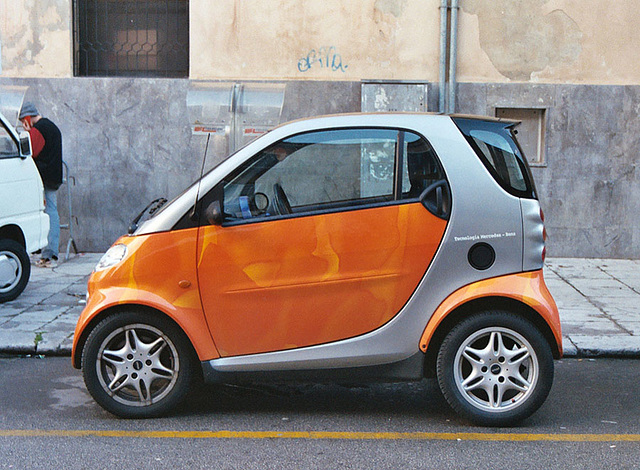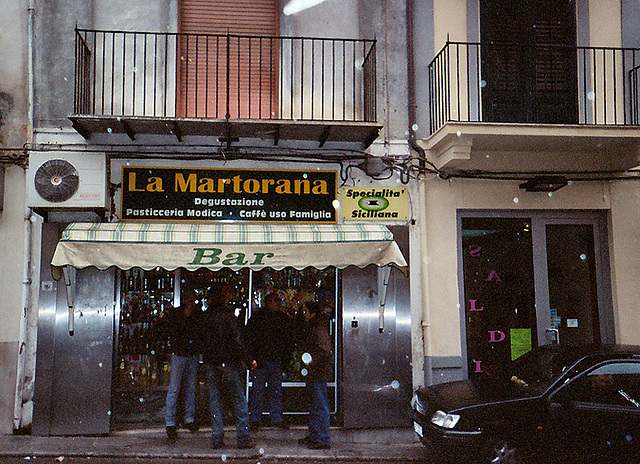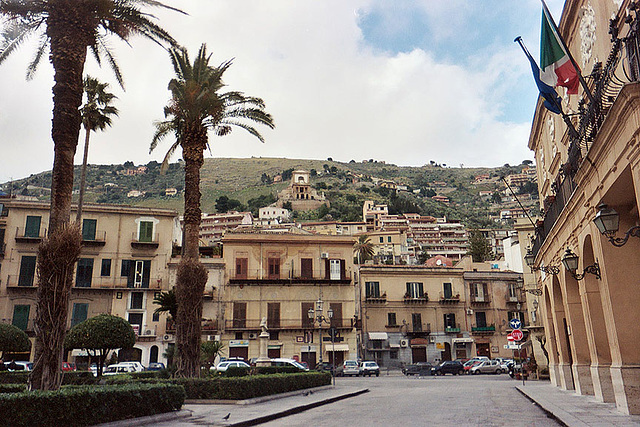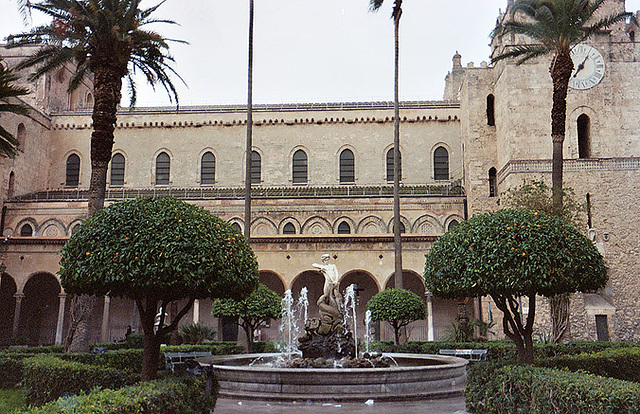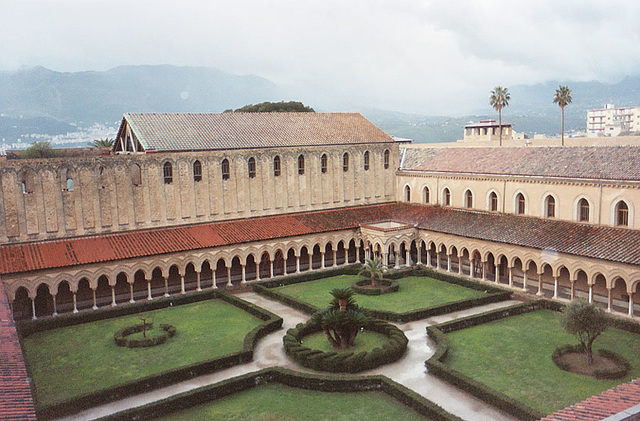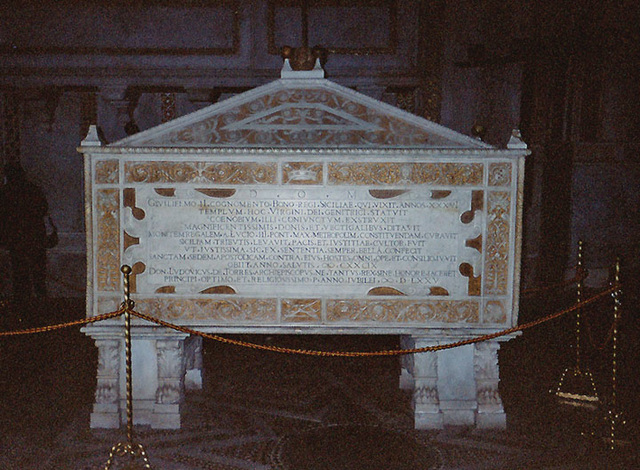
Monreale, March 2005
Folder: Italy
Photos from Monreale, a hill-town near Palermo, best known for its lovely Norman Cathedral, taken in March, 2005 on a rainy day.
01 Mar 2005
Mercedes Smart Car in Monreale, March 2005
Two person "Smart Car" by Mercedes. Isn't it cute?
Monreale (contraction of monte-reale, so-called from a palace built here by Roger I of Sicily) is a small city in the province of Palermo, in Sicily, Italy, on the slope of Monte Caputo, overlooking the beautiful and very fertile valley called "La Conca d'oro" (the Golden Shell), famed for its orange, olive and almond trees, the produce of which is exported in large quantities. The town has approximately 30,000 and is located 15 km (12 mi) south of Palermo.
The town, which for long was a mere village, owed its origin to the founding of a large Benedictine monastery, with its church, the seat of the metropolitan archbishop of Sicily.
Text (after the first paragraph) from: en.wikipedia.org/wiki/Monreale
01 Mar 2005
"La Martorana" Bar in Monreale in the Rain, March 2005
Monreale (contraction of monte-reale, so-called from a palace built here by Roger I of Sicily) is a small city in the province of Palermo, in Sicily, Italy, on the slope of Monte Caputo, overlooking the beautiful and very fertile valley called "La Conca d'oro" (the Golden Shell), famed for its orange, olive and almond trees, the produce of which is exported in large quantities. The town has approximately 30,000 and is located 15 km (12 mi) south of Palermo.
The town, which for long was a mere village, owed its origin to the founding of a large Benedictine monastery, with its church, the seat of the metropolitan archbishop of Sicily.
Text from: en.wikipedia.org/wiki/Monreale
01 Mar 2005
View From the Cathedral of Monreale, March 2005
Monreale (contraction of monte-reale, so-called from a palace built here by Roger I of Sicily) is a small city in the province of Palermo, in Sicily, Italy, on the slope of Monte Caputo, overlooking the beautiful and very fertile valley called "La Conca d'oro" (the Golden Shell), famed for its orange, olive and almond trees, the produce of which is exported in large quantities. The town has approximately 30,000 and is located 15 km (12 mi) south of Palermo.
The town, which for long was a mere village, owed its origin to the founding of a large Benedictine monastery, with its church, the seat of the metropolitan archbishop of Sicily.
Text from: en.wikipedia.org/wiki/Monreale
01 Mar 2005
A Street Near the Cathedreal of Monreale, March 2005
Monreale (contraction of monte-reale, so-called from a palace built here by Roger I of Sicily) is a small city in the province of Palermo, in Sicily, Italy, on the slope of Monte Caputo, overlooking the beautiful and very fertile valley called "La Conca d'oro" (the Golden Shell), famed for its orange, olive and almond trees, the produce of which is exported in large quantities. The town has approximately 30,000 and is located 15 km (12 mi) south of Palermo.
The town, which for long was a mere village, owed its origin to the founding of a large Benedictine monastery, with its church, the seat of the metropolitan archbishop of Sicily.
Text from: en.wikipedia.org/wiki/Monreale
01 Mar 2005
The Exterior of the Cathedral of Monreale, 2005
The Cathedral of Monreale is the greatest of all the monuments of the wealth and artistic taste of the Norman kings in northern Sicily. It was begun about 1170 by William II, and in 1182 the church, dedicated to the Assumption of the Virgin Mary, was, by a bull of Pope Lucius III, elevated to the rank of a metropolitan cathedral.
The outside of the Arab-Norman cathedral is plain, except the aisle walls and three eastern apses, which are decorated with intersecting pointed arches and other ornaments inlaid in marble.
The archiepiscopal palace and monastic buildings on the south side were of great size and magnificence, and were surrounded by a massive precinct wall, crowned at intervals by twelve towers. This has been mostly rebuilt, and but little now remains except ruins of some of the towers, a great part of the monks' dormitory and frater, and the splendid cloister, completed about 1200.
This last is well preserved, and is one of the finest Italian cloisters both for size and beauty of detail now extant. It is about 170 sq. feet, with pointed arches decorated with diaper work, supported on pairs of columns in white marble, 216 in all, which were alternately plain and decorated by bands of patterns in gold and colors, made of glass tesserae, arranged either spirally or vertically from end to end of each shaft. The marble caps are each richly carved with figures and foliage executed with great skill and wonderful fertility of invention, no two being alike. At one angle, a square pillared projection contains the marble fountain or monks' lavatory, evidently the work of Muslim sculptors.
The church's plan is a mixture of Eastern Orthodox and Roman Catholic arrangement. The nave is like an Italian basilica, while the large triple-apsed choir is like one of the early three-apsed churches, of which so many examples still exist in Syria and other Oriental countries. It is, in fact, like two quite different churches put together endwise.
The outsides of the principal doorways and their pointed arches are magnificently enriched with carving and colored inlay, a curious combination of three styles - Norman-French, Byzantine and Arab.
The basilican nave is wide, with narrow aisles. Monolithic columns of grey oriental granite (except one, which is of cipollino), evidently the spoils of older buildings, on each side support eight pointed arches much stilted. The capitals of these (mainly Corinthian) are also of the classical period. There is no triforium, but a high clerestory with wide two-light windows, with simple tracery like those in the nave-aisles and throughout the church, which give sufficient (if anything too much) light.
The other half, Eastern in two senses, is both wider and higher than the nave. It also is divided into a central space with two aisles, each of the divisions ending at the east with an apse. The roofs throughout are of open woodwork very low in pitch, constructionally plain, but richly decorated with color, now mostly restored. At the west end of the nave are two projecting towers, with a narthex (entrance) between them. A large open atrium, which once existed at the west, is now completely destroyed, having been replaced by a Renaissance portico.
It is, however, the large extent (6,500 2) and glittering splendour of the glass mosaics covering the interior which make this church so splendid. With the exception of a high dado, itself very beautiful, made of marble slabs with bands of mosaic between them, the whole interior surface of the walls, including soffits and jambs of all the arches, is covered with minute mosaic-pictures in brilliant colors on a gold ground. The mosaic pictures are arranged in tiers, divided by horizontal and vertical bands. In parts of the choir there are five of these tiers of subjects or single figures one above another.
Although not so refined as mosaics in Cefalù and the Palazzo dei Normanni, the cathedral interior nevertheless contains the largest cycle of Byzantine mosaics extant in Italy.The half dome of the central apse has a colossal half-length figure of Christ
01 Mar 2005
The Belltower of the Cathedral of Monreale, 2005
The Cathedral
The Cathedral of Monreale is the greatest of all the monuments of the wealth and artistic taste of the Norman kings in northern Sicily. It was begun about 1170 by William II, and in 1182 the church, dedicated to the Assumption of the Virgin Mary, was, by a bull of Pope Lucius III, elevated to the rank of a metropolitan cathedral.
The outside of the Arab-Norman cathedral is plain, except the aisle walls and three eastern apses, which are decorated with intersecting pointed arches and other ornaments inlaid in marble.The archiepiscopal palace and monastic buildings on the south side were of great size and magnificence, and were surrounded by a massive precinct wall, crowned at intervals by twelve towers. This has been mostly rebuilt, and but little now remains except ruins of some of the towers, a great part of the monks' dormitory and frater, and the splendid cloister, completed about 1200.
This last is well preserved, and is one of the finest Italian cloisters both for size and beauty of detail now extant. It is about 170 sq. feet, with pointed arches decorated with diaper work, supported on pairs of columns in white marble, 216 in all, which were alternately plain and decorated by bands of patterns in gold and colors, made of glass tesserae, arranged either spirally or vertically from end to end of each shaft. The marble caps are each richly carved with figures and foliage executed with great skill and wonderful fertility of invention, no two being alike. At one angle, a square pillared projection contains the marble fountain or monks' lavatory, evidently the work of Muslim sculptors.
The church's plan is a mixture of Eastern Orthodox and Roman Catholic arrangement. The nave is like an Italian basilica, while the large triple-apsed choir is like one of the early three-apsed churches, of which so many examples still exist in Syria and other Oriental countries. It is, in fact, like two quite different churches put together endwise.
The outsides of the principal doorways and their pointed arches are magnificently enriched with carving and colored inlay, a curious combination of three styles - Norman-French, Byzantine and Arab.The basilican nave is wide, with narrow aisles. Monolithic columns of grey oriental granite (except one, which is of cipollino), evidently the spoils of older buildings, on each side support eight pointed arches much stilted. The capitals of these (mainly Corinthian) are also of the classical period. There is no triforium, but a high clerestory with wide two-light windows, with simple tracery like those in the nave-aisles and throughout the church, which give sufficient (if anything too much) light.
The other half, Eastern in two senses, is both wider and higher than the nave. It also is divided into a central space with two aisles, each of the divisions ending at the east with an apse. The roofs throughout are of open woodwork very low in pitch, constructionally plain, but richly decorated with color, now mostly restored. At the west end of the nave are two projecting towers, with a narthex (entrance) between them. A large open atrium, which once existed at the west, is now completely destroyed, having been replaced by a Renaissance portico.
It is, however, the large extent (6,500) and glittering splendour of the glass mosaics covering the interior which make this church so splendid. With the exception of a high dado, itself very beautiful, made of marble slabs with bands of mosaic between them, the whole interior surface of the walls, including soffits and jambs of all the arches, is covered with minute mosaic-pictures in brilliant colors on a gold ground. The mosaic pictures are arranged in tiers, divided by horizontal and vertical bands. In parts of the choir there are five of these tiers of subjects or single figures one above another.
Although not so refined as mosaics in Cefalù and the Palazzo dei Normanni, the cathedral interior nevertheless contains the largest cycle of Byzantine mosaics extant in Italy.The half dome of the central apse has a colossal half-length figure
01 Mar 2005
The Cloister Behind the Cathedral of Monreale, 2005
The Cathedral of Monreale is the greatest of all the monuments of the wealth and artistic taste of the Norman kings in northern Sicily. It was begun about 1170 by William II, and in 1182 the church, dedicated to the Assumption of the Virgin Mary, was, by a bull of Pope Lucius III, elevated to the rank of a metropolitan cathedral.
The archiepiscopal palace and monastic buildings on the south side were of great size and magnificence, and were surrounded by a massive precinct wall, crowned at intervals by twelve towers. This has been mostly rebuilt, and but little now remains except ruins of some of the towers, a great part of the monks' dormitory and frater, and the splendid cloister, completed about 1200.
This last is well preserved, and is one of the finest Italian cloisters both for size and beauty of detail now extant. It is about 170 sq. feet, with pointed arches decorated with diaper work, supported on pairs of columns in white marble, 216 in all, which were alternately plain and decorated by bands of patterns in gold and colors, made of glass tesserae, arranged either spirally or vertically from end to end of each shaft. The marble caps are each richly carved with figures and foliage executed with great skill and wonderful fertility of invention, no two being alike. At one angle, a square pillared projection contains the marble fountain or monks' lavatory, evidently the work of Muslim sculptors.
Text from Wikipedia: en.wikipedia.org/wiki/Monreale_Cathedral
Made "Explore" on Feb. 16, 2006.
01 Mar 2005
The Tomb of William II in the Duomo of Monreale, March 2005
William II (1153–1189), called the Good, was king of Sicily and Naples from 1166 to 1189.
William was only thirteen years old at the death of his father William I, when he was placed under the regency of his mother, Margaret of Navarre.
Until the king came of age in 1171 the government was controlled first by the chancellor Stephen du Perche, cousin of Margaret (1166–1168), and then by Walter Ophamil, archbishop of Palermo, and Matthew of Ajello, the vice-chancellor.
William's character is very indistinct. Lacking in military enterprise, secluded and pleasure-loving, he seldom emerged from his palace life at Palermo. Yet his reign is marked by an ambitious foreign policy and a vigorous diplomacy. Champion of the papacy and in secret league with the Lombard cities he was able to defy the common enemy, Frederick I Barbarossa. In 1174 and 1175 he made treaties with Genoa and Venice and his marriage in February 1177 with Joan, daughter of Henry II of England and Eleanor of Aquitaine, marks his high position in European politics.
In July 1177, he sent a delegation of Archbishop Romuald of Salerno and Count Roger of Andria to sign the Treaty of Venice with the emperor. To secure the peace, he sanctioned the marriage of his aunt Constance, daughter of Roger II, with Frederick's son Henry, afterwards the emperor Henry VI, causing a general oath to be taken to her as his successor in case of his death without heirs. This step, fatal to the Norman kingdom, was possibly taken that William might devote himself to foreign conquests.
Unable to revive the African dominion, William directed his attack on Egypt, from which Saladin threatened the Latin kingdom of Jerusalem. In July 1174, 50,000 men were landed before Alexandria, but Saladin's arrival forced the Sicilians to re-embark in disorder. A better prospect opened in the confusion in Byzantine affairs which followed the death of Manuel Comnenus (1180), and William took up the old design and feud against Constantinople. Durazzo was captured (June 11, 1185). Afterwards while the army marched upon Thessalonica, the fleet sailed towards the same target capturing on their way the Ionian islands of Corfu, Cephalonia, Ithaca and Zakynthos. In August Thessalonica surrendered to the joint attack of the Sicilian fleet and army.
The troops then marched upon the capital, but the troops of the emperor Isaac Angelus overthrew the invaders on the banks of the Strymon (September 7, 1185). Thessalonica was at once abandoned and in 1189 William made peace with Isaac, abandoning all the conquests. He was now planning to induce the crusading armies of the West to pass through his territories, and seemed about to play a leading part in the Third Crusade. His admiral Margarito, a naval genius equal to George of Antioch, with 60 vessels kept the eastern Mediterranean open for the Franks, and forced the all-victorious Saladin to retire from before Tripoli in the spring of 1188.
In November 1189 William died, leaving no children. Though Orderic Vitalis records a (presumably short-lived) son in 1181: Bohemond, Duke of Apulia. His title of "the Good" is due perhaps less to his character than to the cessation of internal troubles in his reign. The "Voyage" of Ibn Jubair, a traveller in Sicily in 1183-1185, shows William surrounded by Muslim women and eunuchs, speaking and reading Arabic and living like "a Moslem king."
Text from: en.wikipedia.org/wiki/William_II_of_Sicily
Jump to top
RSS feed- Latest items - Subscribe to the latest items added to this album
- ipernity © 2007-2024
- Help & Contact
|
Club news
|
About ipernity
|
History |
ipernity Club & Prices |
Guide of good conduct
Donate | Group guidelines | Privacy policy | Terms of use | Statutes | In memoria -
Facebook
Twitter

